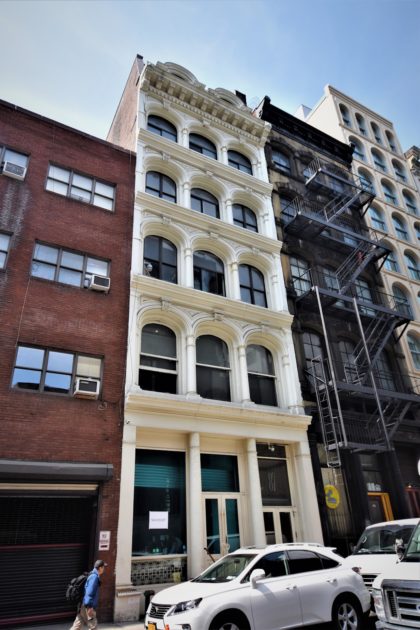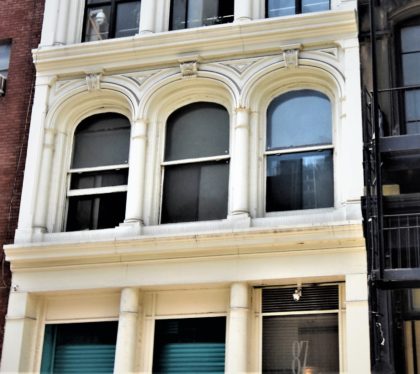The History of 87 Walker
 Tom Miller, who writes about the history of Manhattan buildings at Daytonian in Manhattan, has allowed Tribeca Citizen to create a database of his Tribeca posts. If you enjoy these, and you will, then you should definitely check out his website, which also has write-ups about buildings all over the island. And don’t miss his book, Seeking New York: The Stories Behind the Historic Architecture of Manhattan—One Building at a Time.
Tom Miller, who writes about the history of Manhattan buildings at Daytonian in Manhattan, has allowed Tribeca Citizen to create a database of his Tribeca posts. If you enjoy these, and you will, then you should definitely check out his website, which also has write-ups about buildings all over the island. And don’t miss his book, Seeking New York: The Stories Behind the Historic Architecture of Manhattan—One Building at a Time.
··································
 In 1859, banker Samuel D. Babcock tried his hand at real estate development when he partnered with Matthew Morgan in the construction of an elegant, marble-faced commercial building at the corner of Broadway and White Street. It was a lucrative project and it was most likely only the outbreak of Civil War that prevented Babcock from continuing.
In 1859, banker Samuel D. Babcock tried his hand at real estate development when he partnered with Matthew Morgan in the construction of an elegant, marble-faced commercial building at the corner of Broadway and White Street. It was a lucrative project and it was most likely only the outbreak of Civil War that prevented Babcock from continuing.
In 1868, however, he was back in the game. At No. 87 Walker Street was the old, one-story brick house that had once been home to Dr. H. L. B. Lewis. An inventor, he was especially recognized for his “safety locomotive,” a model of which he exhibited at the American Institution in 1847.
Writers for Scientific American were highly impressed. Its “New Inventions” column described the locomotive on September 11 that year as “a wonderful and beautiful invention destined, we think to produce a great revolution in the speed and safety of railroad travel, as it cannot be thrown off the rail by common causes.” The article suggested “a visit to the sanctum of the inventor, No. 87 Walker street, when our opinion will be more than corroborated by an examination.”
But two decades after that article the little Federal-style house was gone. On September 11, 1868, Babcock bought the 24-foot-wide vacant lot from John Fowler for $11,250, or around $200,000 today. He hired architect Edward Wall to design a modern store and loft building on the site.
Completed the following year, the six-story loft and store building wore a cast-iron facade. The relatively new concept not only sped up construction and lowered costs, but had the advantage of being what was touted as “fire-proof.” Wall designed the first five floors in the expected Italianate style, characterized by the round arched openings, foliate keystones, and what was almost doubtlessly intricate Corinthian capitals on the engaged columns that separated them. He then gave the building a stylish, cutting edge touch by turning to the French Second Empire style which had only recently begun appearing in America. The sixth floor took the form of a mansard roof with two projecting dormers with arched pediments.
 The columns of the storefront and the upper floor columns almost assuredly had elaborate Corinthian capitals.
The columns of the storefront and the upper floor columns almost assuredly had elaborate Corinthian capitals.
··································
Among the building’s first tenants were Henry B. Metcalf & Co. and John White, Jr. In August 1871 White hoped to recover his lost pocketbook, announcing in The New York Herald, “Lost—A pocketbook containing nothing valuable, save to the owner. If the finder will return it to the undersigned, at 87 Walker street, he will be suitably rewarded.”
Four months later, it was not a lost pocketbook that was being sought in that newspaper, but John White, Jr. White apparently had stored furniture or other items in the warehouse of E. Martin & Son. Now, most likely looking for payment, that firm could find no trace of him. On December 20, it placed the advertisement, “Information Wanted—Of John White, Jr., formerly of Walker street.” John White, Jr.’s name never again appeared at the Walker Street address and what became of him seems to be a mystery.
In the meantime, the building filled with dry goods dealers. Sharing the building with Henry B. Metcalf & Co. were J. W. Burroughs & Co. and Steiner, Bier & Co.
Baum & Ginsburg was here by 1873. The firm bought and resold excess goods and apparently took advantage of Reconstruction. An advertisement on January 18, 1874 read: “$10,000 to $20,000 cash to any one having a stock of staple Dry Goods, Boots, Shoes or Clothing, suitable for country or Southern trade, and wishing to realize.” The firm’s aggressive buying may have backfired, however. Within the year the company failed, and on December 28 a Marshal’s sale auctioned off “a large lot of store fixtures, consisting of counters, shelving, chairs, desks, office railing, stove, &c.” as advertised in The New York Herald.
Two new tenants appeared in 1875—Levy, Leopold & Co., wholesale seller of “gents’ furnishing goods,” and Homburger & Machol, manufacturing jewelers.
The last quarter of the 19th century saw paper box firms joining the apparel and textile companies. The first to arrive was Henry Meyer, who advertised for “several girls to make paper boxes” on January 16, 1880, adding “none but experienced hands need apply.”
He was joined in the early 1890’s by Walther & Co., whose principal, W. Walther, was subjected to embarrassing press coverage in 1895. On May 28 that year, The Evening World reported that a “middle-aged woman” had appeared in the Tombs Police Court the day before, charged with “threatening and annoying” Walther. Faced with the box manufacturer’s complaint that she was trying to extort money from him, Ottilie Kuehne spelled out to the judge the couple’s scandalous history. She said that 21 years earlier she had born Walther’s child. The married man had paid her “a sum of money weekly for herself and child,” but it did not go as far as it had two decades ago. Walther did not deny “to have wronged her,” but complained, “Last week the woman wrote a threatening letter demanding an increased allowance.” Infuriated that she would ask for more money, he had her arrested. The judge was not sympathetic to the woman’s plight. “She promised Justice Voorhis that she would not make any further trouble and he allowed her to go,” reported the newspaper.
On the third floor was the factory of Gordon & Sopolsky, makers of cloaks and suits. Early on Saturday morning, November 26, 1898, Policeman Coyle noticed smoke coming from the building and went to the firehouse nearby on Elm Street (now Lafayette Street) to report the fire. The Sun reported that Captain Joseph Martin and his men, “without turning out the engine,” walked over to the building to check. “They saw enough in short order, and returning sent out an alarm.” But the delay was critical.
Firefighter Henry Volk led the way up the stairs hauling the heavy hose. “He had not gone many steps before he disappeared in the smoke and darkness,” said The Sun. The men working on the lower levels had just realized that the blazed had burned through the floor when Volk “came tumbling through, still clutching the hose.”
As they grabbed for Volk, one of the firemen hollered, “There comes another!” and Captain Martin fell through. He was buried beneath the debris that accompanied him and firefighters scrambled to find him. “They were looking for him when then saw a hand holding a lantern, and dug in and got him out,” said the article. Both men were injured, Martin’s back was hurt and his right arm dislocated, and Volk had a broken left arm and internal injuries.
Damage to the building was considerable, estimated at about $152,000 in today’s dollars. None of the old tenants returned to the reconstructed structure.
Oscar Smith & Son moved its headquarters into the building before 1901. The far-reaching firm had wood mills in the forest areas of New York, Maine, Vermont, Rhode Island, New Hampshire, Massachusetts, and Connecticut. Instead of producing building lumber or wood for furniture and paneling, it ground the trees for less glamorous purpose. The firm listed among its offerings sawdust, charcoal, “cordwood for fuel,” “slab wood,” and shavings. Sawdust and shavings were essential for keeping ice frozen at a time when ice boxes kept food cold in every American house, hotel and restaurant.
In February, 1904, Industrial Refrigeration noted, “Planer chips are generally conceded to be the best insulation” and noted that bales of such shavings could be obtained from Oscar Smith & Son. “The bales are compressed and weigh about 100 pounds each, and 250 bales comprise a carload.” The mention of a carload was significant, since Oscar Smith & Son advertised “carloads only.”
The firm nearly had to find new headquarters not long after moving in. Fire was discovered in the building on July 13, 1902, but was quickly extinguished. Almost simultaneously another fire was discovered at No. 89 Franklin Street, two blocks away. Neither of the fires caused any damage but both were suspicious. Three days later, 10-year old John Persini and 16-year old August Ferragiari pleaded guilty to attempted arson in both instances. The boys were released, but no doubt not before receiving a severe talking-to from the judge.
On May 1, 1903, the Babcock estate sold No. 87 to the Colonial Real Estate Association for what would be about $1.4 million today. The company resold it in 1911 to Robert Colgate & Co. which hired architects Dodge & Morrison to update the aging structure.
The $10,000 worth of alterations were completed in 1912. No. 87 became home to the Hope Webbing Company, which leased the fourth floor in 1913, and the H. A. Rogers Co., distributors of plumbing fixtures, including the Moncrieff brand “gauge glasses.” Gauge glasses were the heavy-duty glass lenses that protected the pressure gauges on boilers, steam engines and other high-pressure equipment. An article in The International Steam Engineer in August, 1922 (which sounded suspiciously as if written by a H. A. Rogers Co. representative), suggested that an ancient recipe was the secret to Moncrieff’s quality. It said in part: “No doubt you are well informed that many ‘secrets’ concerning the manufacture of glass by the Egyptians have been buried in past ages and considered a ‘lost art.’ Be that as it may, Moncrieff, in the last 50 years, has either rediscovered some of these lost secrets, or has been able to originate the glass he manufacturers; which now gives his glasses the popularity and preference throughout the world. The secret of manufacturing the Moncrieff glass in known only to Moncrieff.”
Trouble came to No. 87 in 1926 at a time when bootleggers were distilling booze in lofts throughout the city. But the illegal trade carried out on the sixth floor by the John Wessman Novelty Company was more insidious.
In July, Department of Justice agents were called to the White Star liner Arabic regarding five suspicious looking cases. One of the crates, all of which were marked “bowling pins and balls,” was opened. It was filled with small packages of morphine. The case was resealed and agents were put on watch to see where the shipment was taken. A trucker arrived on July 12 and drove off with the cases. Agents followed the truck to No. 87 Walker Street. The New York Times reported, “The agents, who now numbered six, entered and found not only the five cases under suspicion, but another five closely resembling them.” Assistant United State Attorney J. Arthur Adler described the staggering find. The five cases contained “224 pounds of morphine, cocaine and heroin” the market value being nearly $600,000.
Despite on-the-scene arrests, including the gang’s leader William Vachuda, alias William Fox, the investigation continued. On January 14, 1927, 32-year old Alice Seaman was arrested in connection to the narcotics ring on charges issued by Ralph Oyler, Chief of the Federal Narcotics Squad. Oyler lived at No. 22 West 77th Street, the same apartment building where wealthy pen manufacturer Ignatz Salz lived. It was a coincidence that most likely caused Salz his life. On the night that Alice Seaman was jailed, Salz answered his doorbell to two men who opened fire on him. There was no attempt at robbery and Salz was left in his doorway to die. Police believed that the hit was intended for Oyler.
On January 27, the Government explained the workings of the gang. Assistant United States Attorney Edward S. Silver said that from February 1 to August 1, 1926, “more than two tons of narcotics were introduced by this ring into the traffic of this country.” He added “The headquarters of the ring were on the top floor of the loft building at 87 Walker Street, ostensibly occupied by a jobber of toys.”
Vachuda and his accomplices paid between $4 and $7.50 an ounce for the narcotics, which they sold to dealers for $12 to $18 an ounce. End users paid about $75 an ounce from street sellers.
The 1930s and ’40s saw a much more reputable tenant list, including Edgewater Manufacturing Company, dealers in office supplies, and John Loyd Co., “rotary cutters and trimmers” which would remain into the 1950s. Anchor Metal Co. was in the building in 1950, as was Hoyt Equipment Company.” Hoyt was still here in 1965.
The expansion of Manhattan’s Chinatown was reflected at No. 87 in the 1970’s when its main tenant was the Seven Seas Printing and Publishing Company. The firm ran six printing presses and photographic reproducing equipment to produce, mainly, foreign language newspapers. An article in The New York Times on October 13, 1979 noted, “Seven Seas is the major occupant of the small, ancient structure at 87 Walker Street, where floors are linked by shabby stairs and a vintage, rope-controlled elevator. There may be a sign with its name in English outside, but if there is, it avoids the quick glance that is more likely to see Seven Seas in a large sign in Chinese lettering.”
In the 1980’s another Asian-owned firm, Lucky Bean Sprouts, occupied the building.
A renovation in 2009 resulted in a new coat of paint and the removal of the old fire escape. It was probably at this time that, for consistency’s sake, the remaining Corinthian capitals were removed.
··································
Photo credits from top: Daytonian in Manhattan (2).













